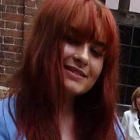Following this trajectory is Margate’s Turner Contemporary’s new exhibition, “Entangled: Threads and Making.” Featuring 40 female artists, the exhibition is curated by Karen Wright and forges a space for work situated on the slippery borderline between high art and the needle.
“The use of materials is the focal point for the exhibition,” says Wright, “the way in which threads are used for experimentation by female artists.” Exploring the textures of fabric, Wright juxtaposes different structures against one another, from the waifish masking tape, cheesecloth, and gluey sculptures of Eva Hesse to the sagging transparency of Karla Black’s What to ask of Others, the sprawling cotton cylinders of Maria Roosen’s After David 2 to Ursula von Rydingsvard’s carnivorous cedar beam jaws.

Ann Cathrin November Høibo, Untitled (Diptych), 2017, Courtesy of the artist and STANDARD, Oslo Photo: Vegard Kleven
Exploring the nature of organic matter, Christiane Löhr’s Entangled collection included drifting little temples out of grass stems, straw, hay and other found materials. For Horse Hair Column she assembled a symmetrical colonnade out of glistening strands of horse tail, linking up the various segments with terse little knots. Delicate and arresting, the structure is so slight one could bust through it on the way to more vivid imagery.
Vibrating against the lithe diaphaneity of Christine Löhr’s sculptures was the defiant figuration and impassioned modernism of Hannah Ryggen’s 6-by-14 foot 6 Oktober 1942 tapestry. Using card, spin and dye wool with lichen, bark, human urine and other natural materials, Ryggen used the needle to weave pungent and affective critiques of humanity.
Chronicling the brutality of National Socialism, Oktober 1942 bears witness to a day in Trondheim when several prominent anti-Nazi resistance leaders were executed and martial law institutionalized the detention of Jews. Branded into the thick reams of cloth is Hitler with oak leaves spilling out of his anus (a symbol of Nazism) and to his right Churchill appears detached and pacified by the violence. A slew of vicious tools smatter across the scene, scissors snap open, blood splurges out of a sliced brain and in the bottom left-hand corner, a mass of tremmering bodies collapse into a mangle of limbs.
Clasping the strands of Ryggen’s artistic legacy was Norwegian artist Ann Cathrin November Høibo whose Untitled Diptych was crafted specifically for Entangled. Mirroring Ryggen’s improvisational style, Høibo avoids any mechanised mode of warp and weft, the work leaves threads trailing or casually clotted up. Alluding to the wider context of industrialisation, Høibo rejects any homespun feel. Cotton, skins and other organic fibres are counterpoised by the suffocating, sweaty plasticity of nylon.
She positions the quivering colours of the first tapestry against the buttery soft white of the second, so that the former screams with violence in a manner akin to the vibrant imagery of Ryggen’s work. Despite being positioned on different walls, through Høibo’s repetition of the same earthy, blood-drenched hues, the two pieces are embroiled in a tonal dialogue.

Karla Black, What To Ask Of Others, 2011, Courtesy the artist, Collezione Maramotti, Reggio Emilia (Italy) and Galerie Gisela Capitain, Cologne Photo: © Dario Lasa
Many of Entangled’s artists drew attention to crafts as a medium. Tatiana Trouvé’s Scale Model for Desire Lines showed cannibalistic sewing reels, the luminescent colours of the threads beautifying the mechanisms exploited for mass-production. Ximena Garrido-Lecca placed an unravelled mass of traditional Peruvian Chullos around their pristinely produced alternative and Japanese artist Aiko Tezuka took outmoded fabric prints and unthreaded them to reveal the fibres that formulate the image.
“I wanted to penetrate the surface," says Tezuka, "to see the invisible things that produce it." Through decomposing the original markings Tezuka sucks the material into the modern, leaving its unfurling centre bleating with the repetitive vibrations of dyed threads.
Located on the seafront amidst the taffy stores and crumbling hotels, the angular spikes of Turner Contemporary are welded into the local community, providing a perfect location for Entangled and these pioneering weavings.
Drowning under London’s extortionate rent prices and cramped landscapes, Margate has become the chosen location for many young creatives. “Here artists have access to studio space and affordable housing," says gallery director Victoria Pomery, "and the introduction of the HS1 train has lead to a massive upsurge in the local area.”

Hannah Ryggen, 6th Oktober, 1942, 1943, Tapestry. Courtesy Nordenfjeldske Kunstindustri –Museum. © DACS 2016
The emphasis on community was a trend which ran throughout the exhibition. For her symmetrical column, Löhr farmed horse hairs from the local riding stables, and Anna Ray’s pixelated mass of knotted branches was woven together by Margate women.
“The audience we attract is not a typical one” says Pomery, “members in the community come here, they bring their children. We pride ourselves on combining the international and the local.”
As you walk to the final part of the exhibition, plastered on the walls is Anni Albers’s mantra, “being creative is not so much the desire to do as the listening to that which one wants to be done: the dictation of materials” — a quote which epitomises the emphasis on the pliable, tactile products of the weaving loom.
Sowing vulgar messages into fabric, creating graphic and pungent forms or crafting subtly conceptual messages, the exhibition uses materiality as a vehicle to weave a resistive dialogue between women, be they artists or local women.
"Entangled: Threads and Making" is on view at Turner Contemporary until May 7, 2017.









